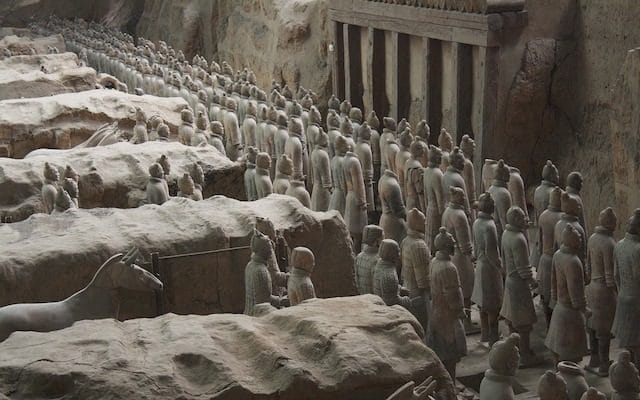Despite all the wonders of the modern world, there’s something to be said about things from the distant past that still amaze us. With modern technology, we often smugly think of ourselves as far more advanced than our ancestors. But then we come across something truly astounding from the ancient world, and all you can do is stand in awe of how it happened. And indeed, some of these relics of ancient history are far more fascinating than you might imagine.
10. Antikythera Mechanism
Computers weren't ubiquitous in our world until the 1990s. Home computers started appearing in the late 1970s, but they were still very rare and very basic. Computers for military and government use had been around since the 1940s. And then there was Antikythera mechanism , a 2,000-year-old bronze artifact located near a Greek island that appears to be a very simple form of computer.
Made of brass gears and dials in a watch-like case, the people who discovered it had no idea what it could be at first. The clockwork technology used in it wouldn’t be used again until around the 16th century. After careful study, a Princeton science historian determined that the device was used to predict the positions of planets and stars based on the month. So it’s essentially a sophisticated map of the sky. If you enter a date, the device will show you where the sun, moon, and planets were in the sky. Essentially, a rudimentary computer that helps you calculate astronomical coordinates quickly and efficiently.
Once the date was entered into the device, precision-made mathematical gears could calculate the angle of the sun's intersection with the sky and use the gear ratios to display everything else. This included the positions of the known planets, the phases of the moon, a full lunar calendar, a predictor of eclipses, constellations, and even a countdown for regular sporting events.
9. Baghdad Battery
Discovered at Hujut Rabu, outside Baghdad, the artifact, which became known as Baghdad Battery , has a plug of asphalt, an iron rod in the center and a copper cylinder around it. If you were to fill the jar with vinegar, it would start producing a charge of 1.1 volts. Hence the name Baghdad Battery. And in a very primitive form, it is a version of what we still use as batteries today. But what is remarkable is that it was made two thousand years ago.
At the time of its discovery, there were no instructions near the battery and no written references to it anywhere else. There has been some speculation over the years as to the nature of the battery, and while it is not generally believed to have been intended to power electrical devices, it could have been used for rudimentary electroplating. It is also possible that it may have been part of some sort of religious ceremony, as touching it would likely have caused a tingling sensation.
8. Nan Madol
Many remarkable ancient cities have been built in the past, but Nan Madol, located in Micronesia, is unique in the world. It is the only ancient city ever discovered that was built on a coral reef. Today, no one lives in the ancient city, and locals believe that it is a place where spirits roam. The people who lived and ruled here for over a thousand years were known as the Saddlers. What they built was something of an engineering marvel.
Nan Madol covers an area of over 200 acres. There are 92 artificial islands that were built between the 13th and 17th centuries. Black lava was taken from the far side of the island and used to build the city. Some segments were up to 20 feet long and were stacked like logs to build the outer walls. How the massive stones were transported is still a mystery, although some people have ventured to suggest that it may have been magic. Considering that some of the cornerstones in one building weigh around 50 tons, it is not hard to see why some locals would make such a guess.
The route to where the stones were taken from is through dense jungle. The island’s population was probably around 30,000, making it a significant undertaking. Factor in the fact that an estimated 750,000 metric tons of stone were used to build the city, and it becomes even more impressive. To put into perspective how heavy it must have been, the locals had no metal. Which means they had no pulleys or levers to move those stones.
7. Gabon reactor
One of the most exciting discoveries in history is one that few people have ever heard of. Located in Gabon, a part of West Africa, is home to the remains of natural nuclear reactor In other words, nature itself created the conditions for nuclear fission to occur almost exactly as it does in a man-made nuclear reactor. And it happened about two billion years ago, long before any life existed that could dream of creating such a thing.
The reactor in Gabon was capable of producing about 100 kilowatts of electricity. Not nearly what real nuclear reactors can produce, but still pretty impressive for something that just happened in the wild.
So how does nature form its own nuclear reactor? Uranium is found naturally in the area and mined for use in man-made reactors. The conditions for uranium fission were ideal, and it continued to work for over a million years. The waste it produced has even been safely stored underground for the past two billion years.
Today, uranium-235 is the most stable fissionable source of nuclear energy and makes up a very small fraction of all the uranium in the world. However, two billion years ago, it was in much higher concentrations, which is what allowed this reaction to occur naturally. All that was really required was to arrange them in the right geometric shape. Along with some kind of moderator to slow down the neutrons, which is usually water and is likely what happened in these natural reactors, and some element to absorb the neutrons, the fission reaction could easily occur.
6. Costa Rican Spheres
Many people in the modern world are puzzled by ancient relics because none of them come with instructions, so it is difficult to understand what some people are doing. Few relics fit this description better than giant stone spheres , scattered throughout Costa Rica.
The massive carved rocks, the largest of which weighs 16 tons and is eight feet in diameter, were largely unknown until fruit companies began clearing the area to grow bananas. 300 balls have been discovered, and no one knows what they are for.
The spheres date back to around 600-1000 AD, before the Spanish came to the area. Their purpose will likely be forever lost to history, and the best researchers have come up with is debunking people's claims about what they are for, since no one really knows.
5. Scythian bongs
Between the 9th century BC and around the 4th century AD, if you traveled across the Central Eurasian steppes, you would have found a Scythian population. These nomadic tribes roamed the area and were known as impressive warriors, some of the first to practice mounted warfare. And they also clearly enjoyed a good high.
Archaeologists have discovered 2,400-year-old stones on Russian territory solid gold bongs , which were used by the Scythians. The bong still contains traces of cannabis and opium. This is consistent with historical accounts of Scythian warriors who were known to smoke and make tea from herbs that were said to alter their state of mind somewhat.
4. Terracotta Army

Story Terracotta Army are quite famous. Created for China's first emperor more than 2,000 years ago, the 7,000 soldiers with their horses and chariots represent one of the most remarkable decorations in archaeological history. But what's a little less well known about the Terracotta Army is the breathtaking amount of detail that went into their creation.
If you've only heard about the army in passing or seen a few pictures, you might not notice some of the more interesting details. For example, all 7,000 soldiers are unique. Some archaeologists believe that each one is carved to represent a real soldier in the imperial army. They are not identical, as they might seem at first glance. They have different hairstyles, different clothes, and different decorations on their uniforms. Most importantly, if you look close enough, you'll see that even their ears are different. Some craftsmen went out of their way to ensure that even the smallest details were present to help distinguish one of these statues from the others.
3. Mummy Dino
These days, discovering dinosaur fossils is nothing out of the ordinary. However, the Nodosaurus fossils discovered in the Millennium Mine in Alberta back in 2011 stand out for something unique in the world. Unlike typical fossils, which are usually just stone bones embedded in real rock, this nodosaur remarkably well preserved. Essentially mummified, the animal's skin remained intact.
Nodosaurus, a type of ankylosaur, was 18 feet long and 3,000 pounds. Researchers believe it likely died near the water before swimming out to sea and then sinking into the mud at the bottom, where it was preserved. The result is not just the skeleton we are used to, but armored plates and scales preserved. The creature’s complete body after it was discovered makes it look more like a sleeping monster than a long-dead fossil.
Not only does this give paleontologists a better understanding of the dinosaur's armor, some of the remains even have color pigmentation that can help reconstruct what these animals actually looked like. Up until now, every time you saw a recreation of a dinosaur, the coloring was simply based on guesswork.
2. Lloyds Bank Coprolite
While you probably shouldn't Google it, you can take for granted that there have been very few excrements of historical significance. That is, when people defecate, it rarely becomes newsworthy, certainly not a matter of historical record. A notable exception is Lloyds Bank coprolite .
The Lloyds Bank Coprolite, dating back to the 9th century, is a fossilised sample of Viking faeces. Measuring eight inches by two inches, it was found beneath the site where Lloyds Bank was building a new location back in 1972. The find was significant both because of its size and because of the fact that fossilised human waste is actually quite rare.
The composition of the fossil shows that the Vikings who left it there had a diet rich in meat, cereal grains, and a small amount of pollen. Also, a huge amount of intestinal parasites. Beyond the grossness, this is an unprecedented window into the life of a Viking of that time. Not just because of the diet, but because of the general discomfort this man must have felt with all the parasites swarming in his guts.
Surprisingly, the coprolite was valued at approximately $39,000.
1. Pyramid of Djoser

The Great Pyramid of Giza gets all the attention from people interested in ancient Egypt, but there is another pyramid worth exploring, and that is the Pyramid of Djoser Dating back to 2630 BC, the Pyramid of Djoser is actually the oldest pyramid in all of Egypt. It is widely believed that this pyramid was the first and most successful pyramid, which in turn led to more pyramids. None of them would have existed if the Pyramid of Djoser had not been successful.
Considering that the engineering feat of building pyramids for people at the time still amazes us today, it is significant that this was the first attempt that was clearly successful. The architect responsible for building the pyramid was a man known as Imhotep, a name you probably recognize from pop culture. It was a mummy in movies about Mummy . He also became the Egyptian god of wisdom and medicine. Not only did they share the same name, but this man was deified after his death and became part of their Pantheon.
The Pyramid of Djoser is much smaller than the Great Pyramid of Giza, but it started a trend and as a result occupies an important place in history.













Оставить Комментарий